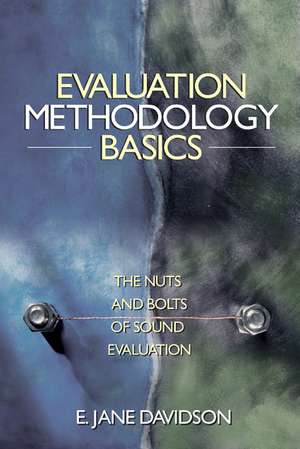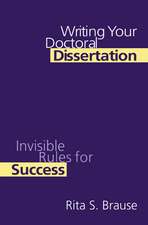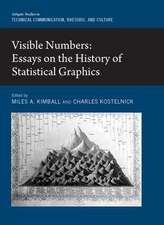Evaluation Methodology Basics: The Nuts and Bolts of Sound Evaluation
Autor E. Jane Davidsonen Limba Engleză Paperback – 21 noi 2004
| Toate formatele și edițiile | Preț | Express |
|---|---|---|
| Paperback (1) | 555.79 lei 6-8 săpt. | |
| SAGE Publications – 21 noi 2004 | 555.79 lei 6-8 săpt. | |
| Hardback (1) | 832.38 lei 6-8 săpt. | |
| SAGE Publications – 7 feb 2005 | 832.38 lei 6-8 săpt. |
Preț: 555.79 lei
Preț vechi: 721.80 lei
-23% Nou
Puncte Express: 834
Preț estimativ în valută:
106.35€ • 111.04$ • 88.02£
106.35€ • 111.04$ • 88.02£
Carte tipărită la comandă
Livrare economică 04-18 aprilie
Preluare comenzi: 021 569.72.76
Specificații
ISBN-13: 9780761929307
ISBN-10: 0761929304
Pagini: 280
Ilustrații: Illustrations
Dimensiuni: 152 x 229 x 15 mm
Greutate: 0.37 kg
Ediția:New.
Editura: SAGE Publications
Colecția Sage Publications, Inc
Locul publicării:Thousand Oaks, United States
ISBN-10: 0761929304
Pagini: 280
Ilustrații: Illustrations
Dimensiuni: 152 x 229 x 15 mm
Greutate: 0.37 kg
Ediția:New.
Editura: SAGE Publications
Colecția Sage Publications, Inc
Locul publicării:Thousand Oaks, United States
Recenzii
“Amidst the wash of methods books available to evaluators, Davidson’s book provides powerful techniques for asking and answering the important foundational questions in any program evaluation.”
“This is a very well written book that offers a unique perspective on long-practiced evaluation techniques and presents several new, potentially very useful, techniques that return “valuation” to the evaluation process.”
"What is evaluation-specific logic and methodology? This book answers that question in a way that is persuasive, accessible, and understandable. It presents a set of principles and procedures to guide the task of blending descriptive data with relevant values to draw explicitly evaluative conclusions. The book makes a significant contribution to positioning evaluation as a unique and special field of inquiry and judgment."
"Evaluation Methodology Basics is yet another excellent book from Sage. This would be a good book to use for a graduate-level course in evaluation techniques or as a template for anyone who is new to the techniques of program evaluation."
"The text is not only a great introduction for novices, but a toolbox with new perspectives for conducting sound evaluation that integrates values with facts into evaluative conclusions. As such Evaluation Methodology Basics should be on every evaluator's shelf."
"I welcome this student-friendly text to complement my favorite checklists. This text develops the core checklist framework to provide evaluation methodology basics for, presumably mainly, introductory courses on program evaluation."
“This is a very well written book that offers a unique perspective on long-practiced evaluation techniques and presents several new, potentially very useful, techniques that return “valuation” to the evaluation process.”
"What is evaluation-specific logic and methodology? This book answers that question in a way that is persuasive, accessible, and understandable. It presents a set of principles and procedures to guide the task of blending descriptive data with relevant values to draw explicitly evaluative conclusions. The book makes a significant contribution to positioning evaluation as a unique and special field of inquiry and judgment."
"Evaluation Methodology Basics is yet another excellent book from Sage. This would be a good book to use for a graduate-level course in evaluation techniques or as a template for anyone who is new to the techniques of program evaluation."
"The text is not only a great introduction for novices, but a toolbox with new perspectives for conducting sound evaluation that integrates values with facts into evaluative conclusions. As such Evaluation Methodology Basics should be on every evaluator's shelf."
"I welcome this student-friendly text to complement my favorite checklists. This text develops the core checklist framework to provide evaluation methodology basics for, presumably mainly, introductory courses on program evaluation."
Cuprins
What is Evaluation?
Basic Definitions
A Note About Fitting Evaluation Approach to Purpose
The Steps Involved
The Ingredients of a Good Evaluation
Identifying the Evaluand
Additional Readings
Exercises
Defining the Purpose of the Evaluation
Evaluations for Determining Overall Quality or Value
Evaluations for Finding Areas for Improvement
Questions About Absolute vs. Relative Quality/Value
Summary and Final Comments
Additional Readings
Exercises
Identifying Evaluative Criteria
Why Not Just Use Goals?
Identifying Criteria: Basic Concepts and Tools
Conducting a Needs Assessment
Identifying Other Relevant Criteria
Additional Readings
Exercises
Organizing the Criteria & Identifying Potential Sources of Evidence
The Importance of Choosing Multiple Sources of Quality Evidence
The Process Evaluation Checkpoint
The Outcome Evaluation Checkpoint
The Comparative Cost-Effectiveness Checkpoint
The Exportability Checkpoint
Additional Readings
Exercises
Dealing With the Causation Issue
Certainty about causation
Inferring causation: Basic principles
Inferring causation: Seven strategies
Choosing a blend of methods to address the causation issue
Additional Readings
Exercises
"Values" in Evaluation
The Controversy
The Three Types of Subjectivity
The Tensions Between Subjectivism and Common Sense
Where do the "Values" in an Evaluation Come From?
Additional Readings
Exercises
Determining Importance
Determining Importance: What and Why
Determining Importance: Six Strategies
Additional Readings
Exercises
The Merit Determination Step
Determining Merit: What and Why
Using Rubrics for Determining "Absolute" Merit
Using Rubrics for Determining "Relative" Merit
Making practical use of merit determination rubrics
Additional Readings
Exercises
Synthesis Methodology
Synthesis: What and Why
The Role of Costs and Comparisons in Synthesis
Synthesizing for "Grading"
Synthesizing for "Ranking"
Additional Readings
Exercises
Putting it All Together
The KEC Preliminary Checkpoints
The KEC Foundations Checkpoints
The KEC Subevaluations Checkpoints
The KEC Conclusions Checkpoints
Additional Readings
Meta-Evaluation
The five criteria for evaluating evaluations
Key points to remember in meta-evaluation
Other options for conducting a meta-evaluation
Formative meta-evaluation
Should I use meta-evaluation myself?
Additional Readings
Exercises
Answers to Selected Exercises
Sample Exam Questions
Tips for students answering these exam questions
The questions
A rubric for grading assignment and exam answers
Suggested answers to practice exam questions
Glossary
References
Basic Definitions
A Note About Fitting Evaluation Approach to Purpose
The Steps Involved
The Ingredients of a Good Evaluation
Identifying the Evaluand
Additional Readings
Exercises
Defining the Purpose of the Evaluation
Evaluations for Determining Overall Quality or Value
Evaluations for Finding Areas for Improvement
Questions About Absolute vs. Relative Quality/Value
Summary and Final Comments
Additional Readings
Exercises
Identifying Evaluative Criteria
Why Not Just Use Goals?
Identifying Criteria: Basic Concepts and Tools
Conducting a Needs Assessment
Identifying Other Relevant Criteria
Additional Readings
Exercises
Organizing the Criteria & Identifying Potential Sources of Evidence
The Importance of Choosing Multiple Sources of Quality Evidence
The Process Evaluation Checkpoint
The Outcome Evaluation Checkpoint
The Comparative Cost-Effectiveness Checkpoint
The Exportability Checkpoint
Additional Readings
Exercises
Dealing With the Causation Issue
Certainty about causation
Inferring causation: Basic principles
Inferring causation: Seven strategies
Choosing a blend of methods to address the causation issue
Additional Readings
Exercises
"Values" in Evaluation
The Controversy
The Three Types of Subjectivity
The Tensions Between Subjectivism and Common Sense
Where do the "Values" in an Evaluation Come From?
Additional Readings
Exercises
Determining Importance
Determining Importance: What and Why
Determining Importance: Six Strategies
Additional Readings
Exercises
The Merit Determination Step
Determining Merit: What and Why
Using Rubrics for Determining "Absolute" Merit
Using Rubrics for Determining "Relative" Merit
Making practical use of merit determination rubrics
Additional Readings
Exercises
Synthesis Methodology
Synthesis: What and Why
The Role of Costs and Comparisons in Synthesis
Synthesizing for "Grading"
Synthesizing for "Ranking"
Additional Readings
Exercises
Putting it All Together
The KEC Preliminary Checkpoints
The KEC Foundations Checkpoints
The KEC Subevaluations Checkpoints
The KEC Conclusions Checkpoints
Additional Readings
Meta-Evaluation
The five criteria for evaluating evaluations
Key points to remember in meta-evaluation
Other options for conducting a meta-evaluation
Formative meta-evaluation
Should I use meta-evaluation myself?
Additional Readings
Exercises
Answers to Selected Exercises
Sample Exam Questions
Tips for students answering these exam questions
The questions
A rubric for grading assignment and exam answers
Suggested answers to practice exam questions
Glossary
References
Notă biografică
Descriere
Evaluation Methodology Basics: The Nuts and Bolts of Sound Evaluation provides a step-by-step guide for doing a real evaluation. It focuses on the main kinds of "big picture" questions that evaluators usually need to answer, and how the nature of such questions is linked to evaluation methodology choices. Jane Davidson explains how to combine a mix of qualitative and quantitative data with "relevant values" (such as needs) to draw explicitly evaluative conclusions. The book presents readers with useful rubrics and flowcharts that may be used during each stage of the evaluation. Many of the concepts presented in the chapters are illustrated with specific examples from a range of disciplines.


















